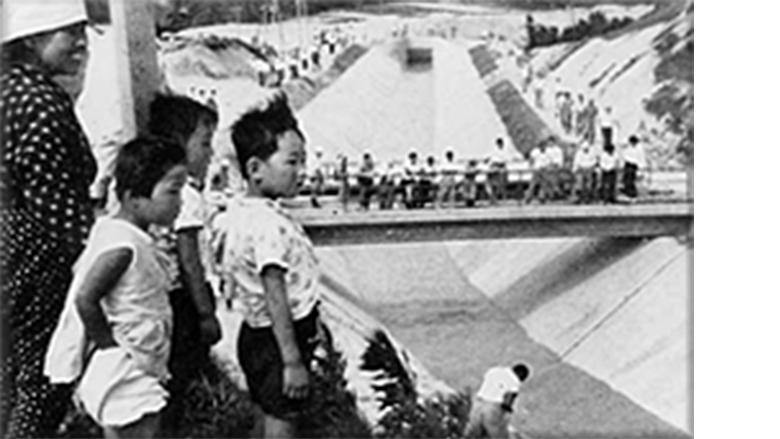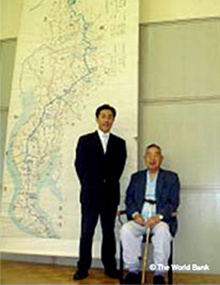
Japan joined the World Bank in August 1952 and borrowed large amounts of money from the World Bank to recover from damage from World War II. In 1957, the Aichi Irrigation Project was launched through an agreement between the Japanese government and the World Bank to provide stable water resources for agriculture, industry and living on the Chita Peninsula of Aichi Prefecture, which had long suffered from drought and water shortages. This project aimed to build the Makio Dam in the upper Kiso River to supply water for agricultural and municipal use essential to agricultural development and industrial growth. The entire construction was completed in a mere 5 years and covered reservoirs such as Aichi Pond, Matsuno Dam and Miyoshi Pond. The main canal stretching 112 km from Kiso River in Gifu Prefecture to the southern edge of the Chita Peninsula, and lateral canals running 1000 km that diverge from the main canal to supply water.

The movement seeking construction of the Aichi Irrigation Project began more than 60 years ago with an idea from Shotaro Kuno, a Chita farmer, and Tatsuo Hamajima, a teacher at an agricultural school. After the great drought of 1947, Mr. Kuno began approaching agricultural groups such as farming village associations and campaigning to build an irrigation canals from the Kiso River to the Chita Peninsula. With Mr. Hamajima support, the pair surveyed and drew up a concept map of Aichi irrigation canals.
In 1948 Mr. Hamajima and Mr. Kuno, realized that the irrigation project required the latest construction techniques and an enormous expense that would have been difficult to domestically fund. In 1950 Shinzo Mori, the then-mayor of the city of Handa, met with Robert Garner, vice president of the World Bank, to discuss the purpose and concepts of the Aichi irrigation canals and requested a loan from the World Bank. Upon onsite inspections and surveys, a US$7 million loan agreement was concluded for the provision of technology of for the Aichi Irrigation Project in 1957.
Before construction began on the Irrigation Project, Japan’s food self-sufficiency ratio (primarily, rice, fish and vegetables) was 80%. The shortfall was covered by imports. Up to 1957, the population was 90 million with 5.5 million tons of food imported annually. The government had to bear costs comparable to US$600 million. The population was estimated to reach 100 million by 1965, and there was concern the food shortage would worsen unless food production in Japan increased.
Agricultural output in the Chita Peninsula increased more than expected after the completion of the project that received various funds, including the loan from the World Bank. Today, more than 50 years after the Aichi irrigation canals were built, Aichi canals not only develop farmland, but also make endeavors such as greenhouse cultivation, orchard farming and livestock farming possible. It has become indispensable to regional growth. Regional agricultural output, which was 25.57 billion yen back in 1963, reached 70.85 billion yen in 1999.
It also provides water for industrial use to 76 places near Nagoya for facilities in areas including the chemical industry and steel industry. Industrial production in the Chita Peninsula in 1963 was 325.9 billion yen based on gross production but grew to 3.865 trillion yen in 1999.
In December 2011, the World Bank Tokyo Office and Japan Water Agency (JWA) held a panel display on the Aichi irrigation project celebrating 50 years since the water first flowed.
Project Data |
| Date of Agreement: August 9, 1957 Beneficiary Company: Aichi Waterworks Corporation Target Project: Aichi Irrigation Project Loan Amount: US$7 million |